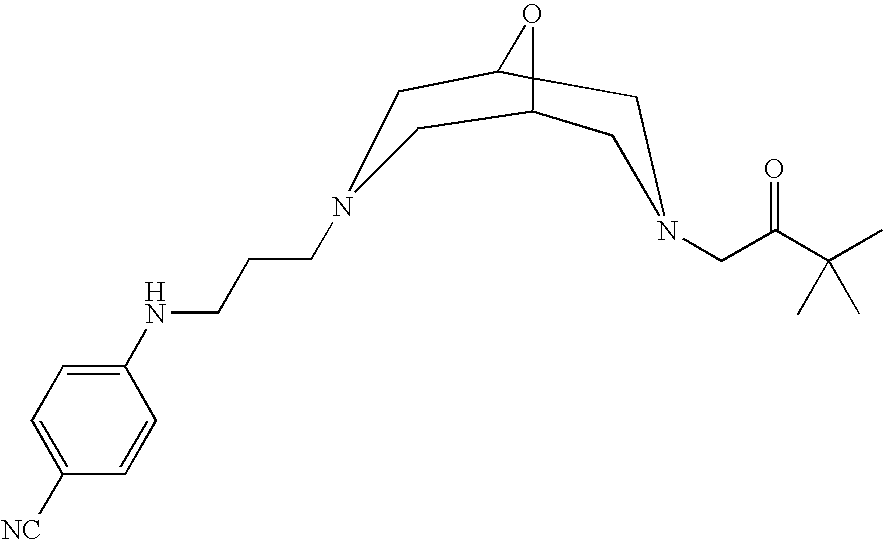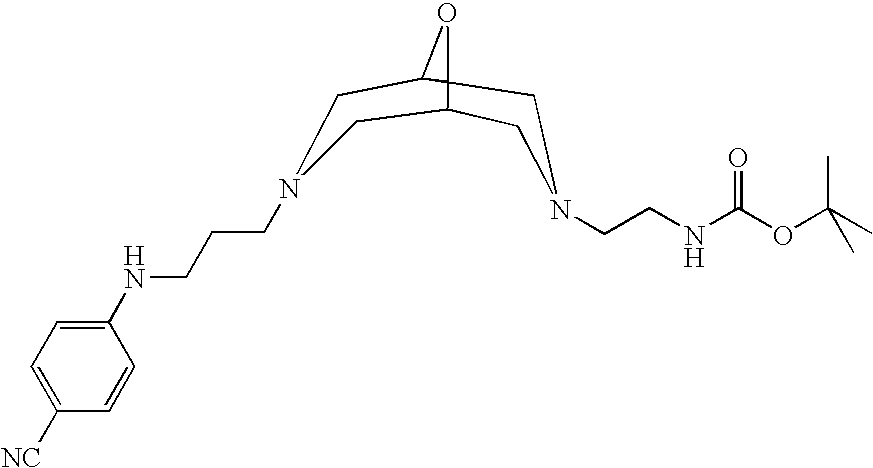Pharmaceutical combination
a technology of pharmaceutically active compounds and combinations, applied in the direction of drug compositions, peptide/protein ingredients, extracellular fluid disorder, etc., can solve the problems of blood pooling in the left atria, blood clot formation, and significant morbidity related to reduced blood flow
- Summary
- Abstract
- Description
- Claims
- Application Information
AI Technical Summary
Benefits of technology
Problems solved by technology
Method used
Image
Examples
example 2
Ph(3-Cl)(5-OCHF2)—(R)CH(OH)C(O)-Aze-Pab(OH)
(i) Ph(3-Cl)(5-OCHF2)—(R)CH(OH)C(O)-Aze-Pab(OH, Teoc)
[0423] Ph(3-Cl)(5-OCHF2)—(R)CH(OH)C(O)-Aze-Pab(Teoc) (0.148 g, 0.24 mmol; see Example 1(ix) above), was dissolved in 9 mL of acetonitrile and 0.101 g (1.45 mmol) of hydroxylamine hydrochloride was added. The mixture was heated at 70° C. for 2.5 h, filtered through Celite® and evaporated. The crude product (0.145 g; 75% pure) was used directly in the next step without further purification.
(ii) Ph(3-Cl)(5-OCHF2)—(R)CH(OH)C(O)-Aze-Pab(OH)
[0424] Ph(3-Cl)(5-OCHF2)—(R)CH(OH)C(O)-Aze-Pab(OH, Teoc) (0.145 g, 0.23 mmol; see step (i) above), was dissolved in 0.5 mL of CH2Cl2 and 9 mL of TFA. The reaction was allowed to proceed for 60 minutes. TFA was evaporated and the residue was purified using preparative HPLC. The fractions of interest were pooled and freeze-dried (2×), yielding 72 mg (yield over two steps 62%) of the title compound.
[0425] MS (m / z) 482 (M−1)−; 484 (M+1)+
[0426]1H-NMR (400 MH...
example 3
Ph(3-Cl)(5-OCHF2)—(R)CH(OH)C(O)-Aze-Pab
[0428] Ph(3-Cl)(5-OCHF2)—(R)CH(OH)C(O)-Aze-Pab(Teoc) (0.045 g, 0.074 mmol; see Example 1(ix) above), was dissolved in 3 mL of TFA and allowed to react for 1 h. TFA was evaporated and the residue was freeze dried from water / acetonitrile to yield 0.043 g (100%) of the sub-title compound as its TFA salt.
[0429]1H-NMR (400 MHz; CD3OD) rotamers: δ 7.8-7.75 (m, 2H), 7.55-7.5 (m, 2H), 7.35 (m, 1H, major rotamer), 7.31 (m, 1H, minor rotamer), 7.19 (m, 1H, major rotamer), 7.15 (m, 1H), 7.12 (m, 1H, minor rotamer), 6.89 (t, 1H, major rotamer), 6.87 (t, 1H, minor rotamer), 5.22 (m, 1H, minor rotamer), 5.20 (s, 1H, major rotamer), 5.13 (s, 1H, minor rotamer), 4.80 (m, 1H, major rotamer), 4.6-4.4 (m, 2H), 4.37 (m, 1H, major rotamer), 4.19 (m, 1H, major rotamer), 4.07 (m, 1H, minor rotamer), 3.98 (m, 1H, minor rotamer), 2.70 (m, 1H, minor rotamer), 2.55 (m, 1H, major rotamer), 2.29 (m, 1H, major rotamer), 2.15 (m, 1H, minor rotamer)
[0430]13C-NMR (100 MHz; ...
example 4
Ph(3-Cl)(5-OCHF2)—(R)CH(OH)C(O)-Aze-Pab(COOcPentyl)
[0432] To a solution of Ph(3-Cl)(5-OCHF2)—(R)CH(OH)C(O)-Aze-Pab×TFA (74 mg, 0.13 mmol; see Example 3 above) and cyclopentylchloroformate (44 mg, 0.30 mmol) in methylene chloride (5 mL) was added aq. NaOH (0.5 mL, 2M, 1 mmol). The mixture was stirred at room temperature and the reaction was monitored with HPLC. After 2.5 hours, water was added and the liquid phases were separated. The aqueous phase was extracted twice with methylene chloride. The combined organic phases were dried (MgSO4) and purified on silica gel (first methylene chloride, then EtOAc).
[0433] After removal of the solvents in vacuo, the solid residue was dissolved in water / acetonitrile and freeze-dried to afford the title compound as a white solid. Yield: 33 mg (44%)
[0434] MS (m / z) 579 (M+1)+
[0435]1H NMR (400 MHz; CD3OD): Λ 7.79(d, 2H), 7.43-7.30(m, 5H), 7.20-7.11(m, 2H), 6.90(t, 1H, major rotamer), 6.87(t, 1H, minor rotamer), 5.19(dd, 1H, minor rotamer), 5.18(s, ...
PUM
 Login to View More
Login to View More Abstract
Description
Claims
Application Information
 Login to View More
Login to View More - R&D
- Intellectual Property
- Life Sciences
- Materials
- Tech Scout
- Unparalleled Data Quality
- Higher Quality Content
- 60% Fewer Hallucinations
Browse by: Latest US Patents, China's latest patents, Technical Efficacy Thesaurus, Application Domain, Technology Topic, Popular Technical Reports.
© 2025 PatSnap. All rights reserved.Legal|Privacy policy|Modern Slavery Act Transparency Statement|Sitemap|About US| Contact US: help@patsnap.com



